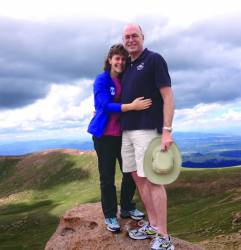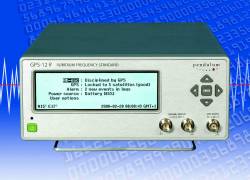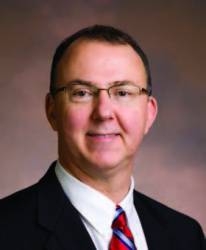 John and his wife, Cindy.
John and his wife, Cindy.With an imposing 6’2” physique and a disarming grin, John Raquet rises above the crowd. To colleagues he’s a top-flight engineer and university professor, and director of the Air Force Institute of Technology (AFIT) Autonomy and Navigation Technology Center. But he is also a former all-star basketball player, a preacher, sometime soccer coach, former military officer, and, most definitely, a family man.
With an imposing 6’2” physique and a disarming grin, John Raquet rises above the crowd. To colleagues he’s a top-flight engineer and university professor, and director of the Air Force Institute of Technology (AFIT) Autonomy and Navigation Technology Center. But he is also a former all-star basketball player, a preacher, sometime soccer coach, former military officer, and, most definitely, a family man.
And boy what a family: wife Cindy plus eight kids, who have managed, among other things, to keep him in wrestling shape.
“Thinking back to when I was a Ph.D. student at the University of Calgary over a three-year period, I remember at times coming home after a frustrating day in my student office and finding the children happy to see me and ready for a good friendly wrestle on the floor,” says Raquet.
“They really didn’t care if I was struggling in a class or couldn’t get a navigation computer program to compile. Playing with them on the floor after a difficult day was an incredible boost, helping me to keep in mind that some things are more important than others,” he continues. “So, rather than being a distraction from my career, I feel like my children have actually helped me to keep things in perspective.”
In the Beginning. . . .
Raquet grew up in the Cleveland, Ohio, area, in a town called North Olmsted. In high school, he worked at a garden center and was pretty serious about basketball, making an all-Cleveland all-star team his senior year.
His mother, Sharon, was a nurse. His father, Charles Raquet, spent his entire career as an engineer at NASA Lewis, now NASA Glenn, in Cleveland.
Charles Raquet completed a Ph.D. in physics from Carnegie Tech, now Carnegie Mellon, when John was about six months old.
Working for NASA, Charles Raquet spent much of his time developing antenna technology for communication satellites. One of the highlights of John Raquet’s undergraduate university days was having an internship at the same NASA facility where his father worked, testing out arcjet engines for spacecraft in 1988.
“Growing up, I had always liked visiting my father’s office and his lab, so it was very exciting to actually be working at the same NASA facility,” John recalls.
By 1989, Raquet had a fine undergraduate career at the U.S. Air Force Academy under his belt and a bachelor of science in astronautical engineering in his pocket, and he was active military. His next move was a master of science program in aeronautical/astronautical engineering at the Massachusetts Institute of Technology. There he worked to develop an innovative, fuel-efficient, collision-avoidance and docking system for the Space Shuttle.
But there was a major development in his personal life as well. While still in graduate school at MIT, he met Cindy, who was working as a recent Wellesley College graduate in a small high-tech company in Boston. She was one of only a few non-engineers.
Cindy has remained a true partner and devoted traveling companion to John throughout the years. “She has attended probably 15 Institute of Navigation [ION] GNSS conferences with me,” he says, “and even though she’s not a navigation engineer, she knows lots of people who attend, because each place that we’ve lived has involved organizations that are active in the ION.”
After receiving his master’s degree, Raquet was assigned to what is now the 746th Test Squadron at Holloman Air Force Base, near Alamogordo, New Mexico.
He was originally told that he was going to be a flight test engineer, and he was very excited about the opportunity to fly as part of his job, but when he arrived, Holloman leaders discovered that Raquet had a masters degree and decided to put him in the reference systems development element.
“This was one of several times in my life where I look back and am glad that I didn’t get what I thought I wanted,” Raquet says, because it put him in the middle of an emerging technology, the Global Positioning System, that was beginning to transform the world of positioning, navigation, and timing.
“In the reference systems element, we were starting to use GPS as an input to our flight reference systems, which were used to generate truth data when testing navigation systems, mostly INS [inertial navigation] at that time,” he says. “During the four years I was there, we went from not using GPS, to using GPS pseudoranges, to pseudorange DGPS [differential GPS], to incorporating a full integer-resolved, carrier-phase DGPS solution into our reference system.”
So, it turned out that working with reference systems allowed Raquet to “cut his teeth” on GNSS and ultimately set the direction for the rest of his career.
Unforgettable
Raquet says he “first got truly excited about GNSS” when Dr. Gérard Lachapelle came to Holloman AFB in the early 1990s to teach a course on carrier-phase integer ambiguity resolution.
“To this day, it still amazes me that, using carrier-phase DGPS, a receiver can tell you where you are within a centimeter, using signals from satellites 20,000 kilometers away and traveling at several kilometers/second.”
In the GPS class that he teaches today, Raquet has all of the students submit a work of “GPS Art” sketched by plotting the position of an GNSS antenna moved in whatever shape they want, using carrier-phase DGPS for positioning. “I suspect that this is a part of the course that they will never forget,” he says, “long after all of the details of the course have faded from memory.”
From New Mexico, it was on to Canada and back to school, this time as a doctoral student in geomatics engineering at the University of Calgary — Lachapelle’s stamping ground — from 1995 to 1998. There Raquet pioneered a new method for network-based precise differential GPS positioning that is currently deployed throughout the world.
And he remained busy on the home front: “Cindy and I started that program with two young children, and left with four — so, there are two Canadians in my family!”
Full Circle
Today, John Raquet is a professor of electrical engineering and Director of the Autonomy and Navigation Technology (ANT) Center at AFIT. Located at Wright Patterson AFB, near Dayton, Ohio, his office is not so very far from where he grew up playing basketball in North Olmsted.
Back in Ohio, Raquet appears to have achieved that much-sought but rarely found work-family balance.
“I absolutely love being a professor and running a research center,” he says. “One of the best parts of my job is getting to know each of my research students as I work with them over an extended period of time. I also have really enjoyed attempting to develop an engaging, fun culture among the ANT Center staff.”
And fun is something he knows about, keeping eight children, ages 8 through 23 — four boys and four girls — entertained and yet on track: traveling, playing whiffle ball in the back yard, hiking, camping, and on and on.
“We recently all took a trip to the Grand Canyon and back in our 15-passenger van, which was a blast!” says Dad.
One of the family highlights was the opportunity for them all to live in Finland for six months in 2010, when Raquet was AFIT’s first-ever Fulbright Scholar at the Tampere University of Technology.
Raquet found the Finnish posting both professionally and personally enriching. “Living in Europe enabled us to show our children quite a few historical sites that we never thought they would be able to see, at least while living in our own home.”
In the midst of this rich family life, however, Raquet has still managed to get a little work done.
In recent years, ANT has developed the Sensor Processing for Inertial Dynamics Error Reduction (SPIDER) filter framework to alleviate some of the issues inherent with specialized navigation post-processing software.
“We got tired having students struggling to reuse sensor integration software, to the point that they would often start over again from scratch,” Raquet explains. “To fix this, we developed the SPIDER filter frame-work, which has a number of nice features that enable the students to add in their own sensor model with-out affecting other sensor models that may already exist. This has significantly improved our ability to reuse this software.”
A familiar face at conferences and events, Raquet has many awards and honors and well more than 100 published articles and conference presentations to his credit as well as a long line of mentored students. And one still has the feeling that he’s just getting started.
“At the Center, we continue to do lots of work in navigation using non- GNSS means,” Raquet explains, “which is almost always more difficult and less accurate than GNSS, when it’s available.”
Recently, ANT has been investigating the use of magnetic field variations to determine absolute position, by comparing the measured variations to a map, demonstrating this capability indoors, in a ground vehicle, and in an aircraft.
“We have been spoiled by GNSS, and have come to depend on it,” Raquet says. “So, it is important to have alternative navigation signals to fall back on, if and when GNSS is not available.”
Imparting Perspective
Raquet has worked for the Air Force for his entire career, initially as an active duty military member and now as a government civilian. He was active duty from 1989 through 2003, which included his first five years as a professor, and then converted to civilian status.
Raquet decided to get out of the military at the 14-year point, six years before he would have reached full retirement, partly so that he could continue to be a professor, which would not have been possible if he had stayed in uniform.
And, as do many parents, he takes a part of his work home with him.
“Like my father, I like to talk with my children about how things work,” Raquet says. “After a number of drawings literally on the back of a napkin, we finally broke down and purchased a whiteboard which was installed in our dining room; so, now it’s much more convenient to make a quick drawing of something.”
Given that the couple — “mostly Cindy,” Raquet insists — have home-schooled all their children, a whiteboard seems a natural furnishing for their dining room.
And that choice seems to have paid off.
“We have three in university — two studying music, and one electrical engineering,” Raquet says. “We really don’t know yet what the other children will study, although my 10-year-old has let us know that he is just biding his time until he can build robots for a living!”
Music is another family activity, both listening and playing. Most of the children play one or two instruments, including, thus far, the harp, violin, two violas, French horn, flute, trombone, and piano. “
“We also enjoy breaking out into spontaneous song from time to time,” he adds.
John and Cindy enjoy music as well, although they spend more time teaching it and driving around to lessons than actually playing anything.
As a man of faith, Raquet is very active in the Arbor Church, a reformed Baptist congregation, as a pastor and, along with Cindy, as a counselor. Together they have provided premarital counseling for a number of couples, and, looking ahead to their 25th anniversary in January, the Raquets would seem to be good models for giving marital advice.
Raquet offers quite a bit of instruction for fellow church members and says he really enjoys preaching things other than engineering.
“It’s amazing how often engineering concepts provide good analogies for spiritual concepts,” he says, “although sometimes I have to pass on the best engineering analogies, because only engineers would really get it!”





